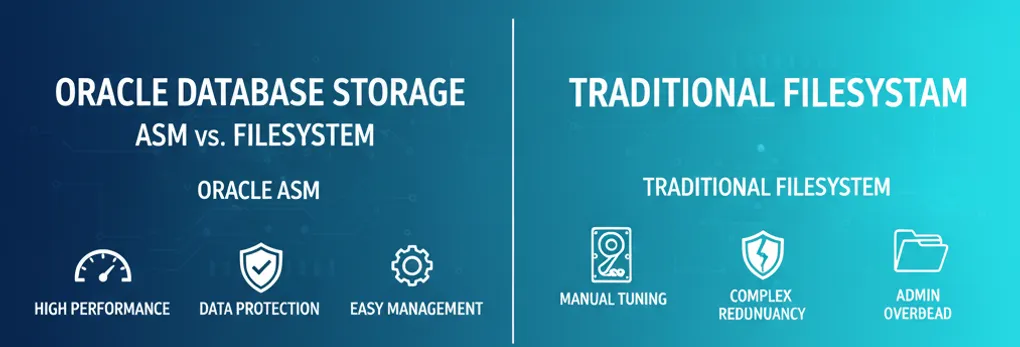
ASM vs File System Storage
ASM vs. File System Storage for Oracle Databases
Audience: Database Administrators and IT Engineers
This post explains the key differences between using a conventional operating system file system and Oracle’s Automatic Storage Management (ASM) for database storage. The goal is to provide a clear comparison for informed storage decisions.
File System Storage
A file system (e.g., XFS, ext4, ZFS, NTFS) is managed by the operating system. The DBA or sysadmin is responsible for creating directories, placing database files (datafiles, control files, redo logs), managing underlying volume managers (LVM) or hardware RAID, balancing I/O, and expanding storage manually when needed.
Automatic Storage Management (ASM)
ASM is Oracle’s volume manager and dedicated file system for database files. It manages disk groups, automatically handling file placement, striping, mirroring, and rebalancing when disks are added. DBAs interact with ASM at the disk group level rather than individual files.
Key Differences
| Aspect | File System Storage | ASM Storage |
|---|---|---|
| Administrative Focus | Files and directories | Disk groups |
| Storage Provisioning | Manual formatting, mounting, directory creation | Add disks to disk group; auto-managed |
| Capacity Expansion | May require downtime and manual migration | Dynamic; online rebalancing |
| Performance | Depends on hardware RAID and manual placement | Automatic striping across all disks |
| Redundancy | OS or hardware RAID | Built-in mirroring (NORMAL/HIGH) |
| File Interface | Standard OS paths | Managed internally; referenced via ASM commands/SQL |
| Oracle RAC Support | Requires cluster FS or NAS | Recommended and fully supported |
When to Use Each
- File System Storage: Suitable for development, test, or small production environments. Ideal if storage features (like snapshots or replication) are provided by the array.
- ASM: Recommended for medium to large production databases, RAC deployments, or environments prioritizing automated management, performance, and redundancy.
File systems provide familiarity and direct control, but ASM delivers a storage management layer optimized for Oracle workloads. For production and RAC deployments, ASM is not just an option—it is a strategic component for performance, scalability, and reliability.